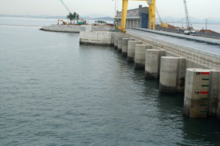
Back طاقة مدجزرية Arabic Enerxía mareomotriz AST Qabarma və çəkilmə enerjisi Azerbaijani Приливна енергия Bulgarian Energia mareomotriu Catalan Egni llanw Welsh Tidevandsenergi Danish Tajda energio Esperanto Energía mareomotriz Spanish Loodete energia Estonian


| Part of a series on |
| Renewable energy |
|---|
 |
| Part of a series on |
| Sustainable energy |
|---|
 |
Tidal power or tidal energy is harnessed by converting energy from tides into useful forms of power, mainly electricity using various methods.
Although not yet widely used, tidal energy has the potential for future electricity generation. Tides are more predictable than the wind and the sun. Among sources of renewable energy, tidal energy has traditionally suffered from relatively high cost and limited availability of sites with sufficiently high tidal ranges or flow velocities, thus constricting its total availability. However many recent technological developments and improvements, both in design (e.g. dynamic tidal power, tidal lagoons) and turbine technology (e.g. new axial turbines, cross flow turbines), indicate that the total availability of tidal power may be much higher than previously assumed and that economic and environmental costs may be brought down to competitive levels.
Historically, tide mills have been used both in Europe and on the Atlantic coast of North America. Incoming water was contained in large storage ponds, and as the tide goes out, it turns waterwheels that use the mechanical power to mill grain.[1] The earliest occurrences date from the Middle Ages, or even from Roman times.[2][3] The process of using falling water and spinning turbines to create electricity was introduced in the U.S. and Europe in the 19th century.[4]
Electricity generation from marine technologies increased an estimated 16% in 2018, and an estimated 13% in 2019.[5] Policies promoting R&D are needed to achieve further cost reductions and large-scale development. The world's first large-scale tidal power plant was France's Rance Tidal Power Station, which became operational in 1966. It was the largest tidal power station in terms of output until Sihwa Lake Tidal Power Station opened in South Korea in August 2011. The Sihwa station uses sea wall defense barriers complete with 10 turbines generating 254 MW.[6]
- ^ Ocean Energy Council (2011). "Tidal Energy: Pros for Wave and Tidal Power". Archived from the original on 2008-05-13.
- ^ "Microsoft Word – RS01j.doc" (PDF). Archived (PDF) from the original on 2011-05-17. Retrieved 2011-04-05.
- ^ Minchinton, W. E. (October 1979). "Early Tide Mills: Some Problems". Technology and Culture. 20 (4): 777–786. doi:10.2307/3103639. JSTOR 3103639. S2CID 112337062.
- ^ Dorf, Richard (1981). The Energy Factbook. New York: McGraw-Hill.
- ^ "Ocean power – Tracking Power 2020 – Analysis". IEA. Archived from the original on 2020-06-19. Retrieved 2020-08-25.
- ^ Glenday, Craig (2013). Guinness world records 2014. Guinness World Records Limited. ISBN 978-1-908843-15-9.